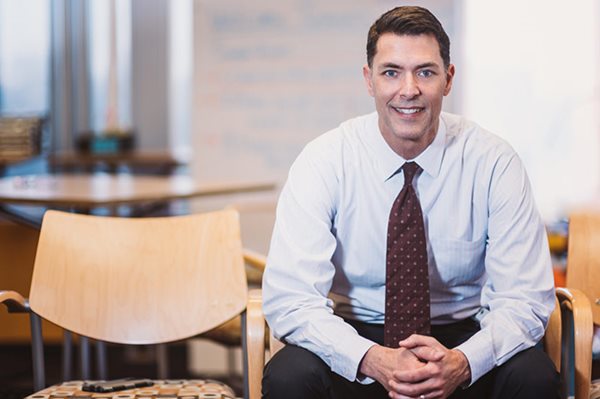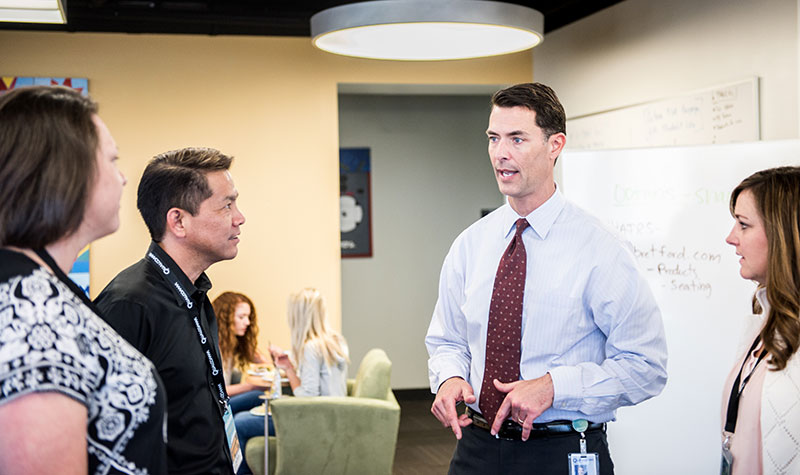5 May 2016
Qualcomm Thinkabit Lab: Giving students something to think about
Middle school students and engineering hardly seem like an easy or potent mix.
However, if you walk into the Qualcomm Thinkabit Lab, the energy and excitement one feels is palpable.
In one area, teachers are working with their students on how to redesign their classrooms to better inspire learning and collaboration. Around the corner, other students are learning the basics of computer coding. Off to the right, a few educators lounge in a brightly colored room filled with more than a dozen bean bag chairs and signs listing careers and personality characteristics.
While it might seem like a jumble of activity, the aim of the Thinkabit Lab is quite clear: to introduce these students not only to marvels of engineering and innovation, but also to the world of work.

It is also a place where dreams begin to take seed, said Ed Hidalgo, senior director of government affairs at Qualcomm and the driving force behind Thinkabit.
“This is about inspiring kids from all socio and economic backgrounds to get interested in STEAM (which is short for science, technology, engineering, arts, and math) and exposing educators to new environments and maybe new ways to teach,” he said.
Since opening in March 2014, Thinkabit has welcomed thousands of sixth through eighth graders from around the region to explore a variety of careers as well as learn the basic building blocks of engineering.
The reasoning is simple. Young people may have access to the many wonders of today’s technology, but it’s unlikely they realize that many San Diego companies are deeply involved in that growth. And here’s the big thing: this lets them know they can one day be a part of it.
David Miyashiro, the superintendent of the Cajon Valley Union School District, said Thinkabit is helping transform education locally and beyond.
“Ed has catalyzed the conversation about education across the county and now across the country,” he said. “He created a solution for K–12 education when we didn’t know a problem existed.”
That problem facing schools, Miyashiro explained, is that education has not kept up with the demands of the innovation economy.
“The skills and experience kids need today are creativity and collaboration,” he said. “Our curriculum doesn’t always reflect that.”
Thinkabit was born from a program Hidalgo lead at Qualcomm to boost job satisfaction and career management among its employees. He realized that the positive impact that it had on employees, could be expanded and be especially useful to students who were beginning to think about possible careers.
“People were often searching for greener pastures, and what we found was they often weren’t in the right role, but they didn’t know how to develop in that role or how to get prepared for their next move. They didn’t know how to change their situation,” he said.
“We wanted to help teach people to own their career because today it is no longer a career ladder but a career lattice. You need to be able to manage your career in all different directions.”
With that, he led a team that helped develop a program in which people could explore their strengths and interests, so they can be better informed regarding their career choices.
“It was like, ‘Wow, there can be so much impact if we take these assessments and high quality coaching and help students discover their unique strengths, interests, and values and discover where they could be needed in the world,’” Hidalgo said.
Ed Abeyta, assistant dean for community engagement and director of pre-college programs for UC San Diego Extension, who works closely with Hidalgo on STEAM initiatives, said Hidalgo has the right approach to engaging young people to envision their future.
“Thinkabit focuses on exposing the students to many different options instead of having an individual pursue a career without any insight into how that career fits with a student’s talents or personality,” Abeyta said.
Because of that, Thinkabit’s world of work is wide open with possibilities, and students are asked to consider a variety of careers, including that of a writer, graphic designer, chef, and, of course, an engineer.
Still, the Thinkabit Lab is firmly committed to STEAM education—with classes in coding and robotics—that also incorporates creativity and teamwork.
“The real magic is when you have engineering combined with art,” Hidalgo said “And our team has done an amazing job of creating a student centered space that combines art and engineering.”
To spread that magic to a larger audience, Hidalgo and team knew they needed help; so they paired up with UC San Diego Extension to launch the STEAM Channel, an online channel that explores all facets of science, technology, engineering, arts, and math through cutting-edge programming. UC San Diego Extension runs UCTV (www.uctv.tv/) and also has a number of online channels, including the Brain Channel and the Career Channel. Since it first launched in March 2015, the STEAM Channel has had more than 1.8 million hits.
“The STEAM Channel is huge because there are so many schools that can’t come to us,” Hidalgo said. “We can take this online and create a global platform.”

To reach even more students and prepare them for local jobs, Thinkabit has expanded its reach by opening three Thinkabit Labs at three local middle schools in San Diego, Chula Vista, and Vista. They are also working to support San Diego Mayor, Kevin Faulconer’s initiative to create more makerspaces in the region by partnering with other local corporations like SeaWorld and Raytheon. There is even a plan for a Thinkabit Lab in northern Virginia.
The increased reach is important, Hidalgo said, because Thinkabit is changing kids’ lives by giving them a window into a brighter future.
Recently, a student at the Thinkabit Lab seemed so withdrawn that the Thinkabit staff thought something was wrong. One of the team members went over to check on him, asking if he was OK.
“He sat up and said, ‘I’ve just been sitting here thinking: how can I work here one day,’ Hidalgo said. “These kids internalize the lessons they learn here. They are like, “‘I’ve got to do this.’”